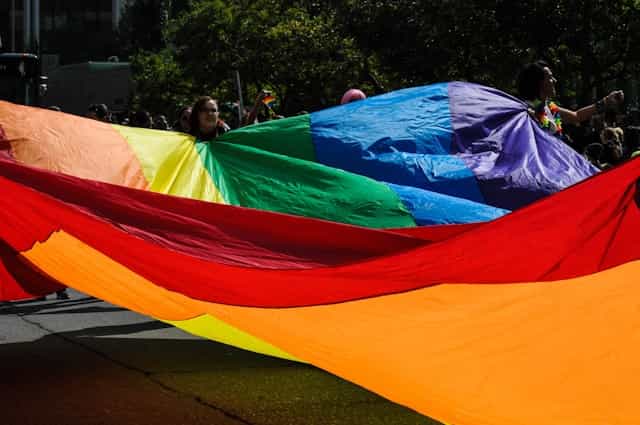June is dedicated to celebrating Pride Month. Members of the LGBTQ community hold events and celebrations to acknowledge the progress and contributions made. It’s also a time to raise awareness about the issues they are dealing with.
The United States is one of the best places to attend Pride Month, as different sections of the country hold gatherings that accommodate members of different ages. Some countries celebrate Pride Month in other months, like February, August and September.
Become an insider. Subscribe to our newsletter for more top trending stories like this!
Have you ever wondered about the origins of this event? In this piece, we explore that and more.
People Also Read: 10 Black Celebrities Raising the Rainbow Flag High
You can buy a pride flag on Amazon.
Origins of Pride Month

With the acceptance and legalization of gay rights, you’ve probably learnt more about the LGBTQ community and the Pride Month is a good time to educate yourself. It’s also important to understand the origins of these month-long celebrations.
People Also Read: Short Black Actors: List of the 7 Shortest Black Celebrities
Buy these pride decorations on Amazon.
Beginnings of Pride Month
The gay rights movement can be traced back to the 1900s. In the 1920s, Henry Gerber started one the earliest organizations supporting the community, the Society for Human Rights. After World War II, more groups emerged, notably the Mattachine Society and the Daughters of Bilitis, which created awareness about the group, demanding recognition of their rights.
Transgender and LGBTQ people didn’t have rights afforded to other people. To break that, in 1966, the Mattachine Society organized a sip in protest in Julius Bar, New York, demanding drinks which went against laws that barred people in the LGBTQ community from being served.
Four years before the Stonewall Riots in New York City, activists in Philadelphia held protests on July 4 outside Independence Hall to demand the legalization of LGBTQ rights but were unsuccessful. However, things changed in June 1969, as explained in the next section.
People Also Read: 7 Biggest Black Celebrity Scandals of the 2000s You Probably Don’t Remember
Get more pride accessories to celebrate this month on Amazon.
Stonewall Riots
As a result of restricting laws against the LGBTQ community, the New York police carried out raids in gay bars and restaurants. In 1966, they landed at the Stonewall Inn in Greenwich Village, Manhattan, forcefully and violently removing people from the Inn.
In years gone, people would stand by watching police harassment of bars patrons but on this occasion, they retaliated violently. This led to a six-day protest, the Stonewall Uprising, across Christopher Street and the wider New York City.
The clashes ended on 2 July 1969. These events shed light on gay rights and the issue became a national conversation.
People Also Read: The Top U.S Easter Destinations for a Weekend Getaway
Become an insider. Subscribe to our newsletter for more top trending stories like this!
First Gay Pride Parade
On 28 June 1970, the Eastern Regional Conference of Homophile Organizations (ERCHO) and the Christopher Street Liberation Day Umbrella Committee commemorated the Stonewall Riots events in New York City, marching through Manhattan.
The march was labeled the Christopher Street Liberation Day March and went down in history as the first gay pride march. About 3,000 to 5,000 people are believed to have attended the event held in Los Angeles along Hollywood Boulevard, Chicago and San Francisco.
LGBTQ activist Craig Schoonmaker is believed to be behind the term “Pride.” He initially wanted to use the phrase Gay Power but he didn’t like it. Also, he thought that few people have power so it doesn’t fit. However, people can have pride in themselves hence the phrase “Gay Pride”. Shoonmaker told The Allusionist Podcast.
Join our Spotcovery Global Black Community Facebook Group for early access to exclusive content and to share in a lively discussion.
Evolution of Gay Pride Month

After years of existence, former United States President Bill Clinton ratified Gay and Lesbian Pride Month as a federal holiday in June 1999.
In 2009, former President Barack Obama chose the name Lesbian, Gay, Bisexual and Transgender Pride Month and designated the Stonewall National Monument in honor of the origins of Pride Month.
President Joe Biden expanded the month to the Lesbian, Gay, Bisexual, Transgender, and Queer (LGBTQ+) Pride Month.
The month-long event culminates in Gay Pride Day on the last Sunday of June. Different pride parades have different themes:
- Washington, D.C.: “Totally Radical.”
- Los Angeles: “Power in Pride.”
- San Francisco: “Beacon of Love.”
- New York: “Reflect. Empower. Unite.”
How The Rainbow Flag Became a Symbol of Pride Month
The rainbow flag has been the symbol of the LGBTQ community since Gilbert Baker designed the first flag in 1978. It was first used during the San Francisco Gay Freedom Day Parade. Baker says he borrowed the colors of the rainbow and each has a meaning:
- Hot pink – sex
- Red – life
- Orange – healing
- Yellow – sunlight
- Green – nature
- Turquoise – art
- Indigo – harmony
- Violet – spirit
As years went by, Baker wanted to do mass productions which led to removing the pink and turquoise colors. Blue replaced the Indigo, and this is the flag currently used. The flag became the symbol of the LGBTQ community in 1994.
Now you know about the origins of Pride Month. The movement has come a long way and continues to grow. Have you ever attended Pride Month? Share your experience in the comments below.
Nearly 80% of consumers visit directories with reviews to find a local business. List your business for free in our exclusive Spotcovery Black-Owned Business Directory.
Spotcovery offers unique and fresh daily content on Black culture, lifestyle, and experiences. We talk about everything black, black people, black-owned and black-owned businesses. We also deliver authentic and relevant content that will inform, inspire, and empower you! The future of black media is critical to today’s black experience! Our primary audience includes African Americans, Africans, Afro-Caribbean, and people of African heritage. Black culture is for the culture!
Become an insider. Subscribe to our newsletter for more top trending stories like this!





